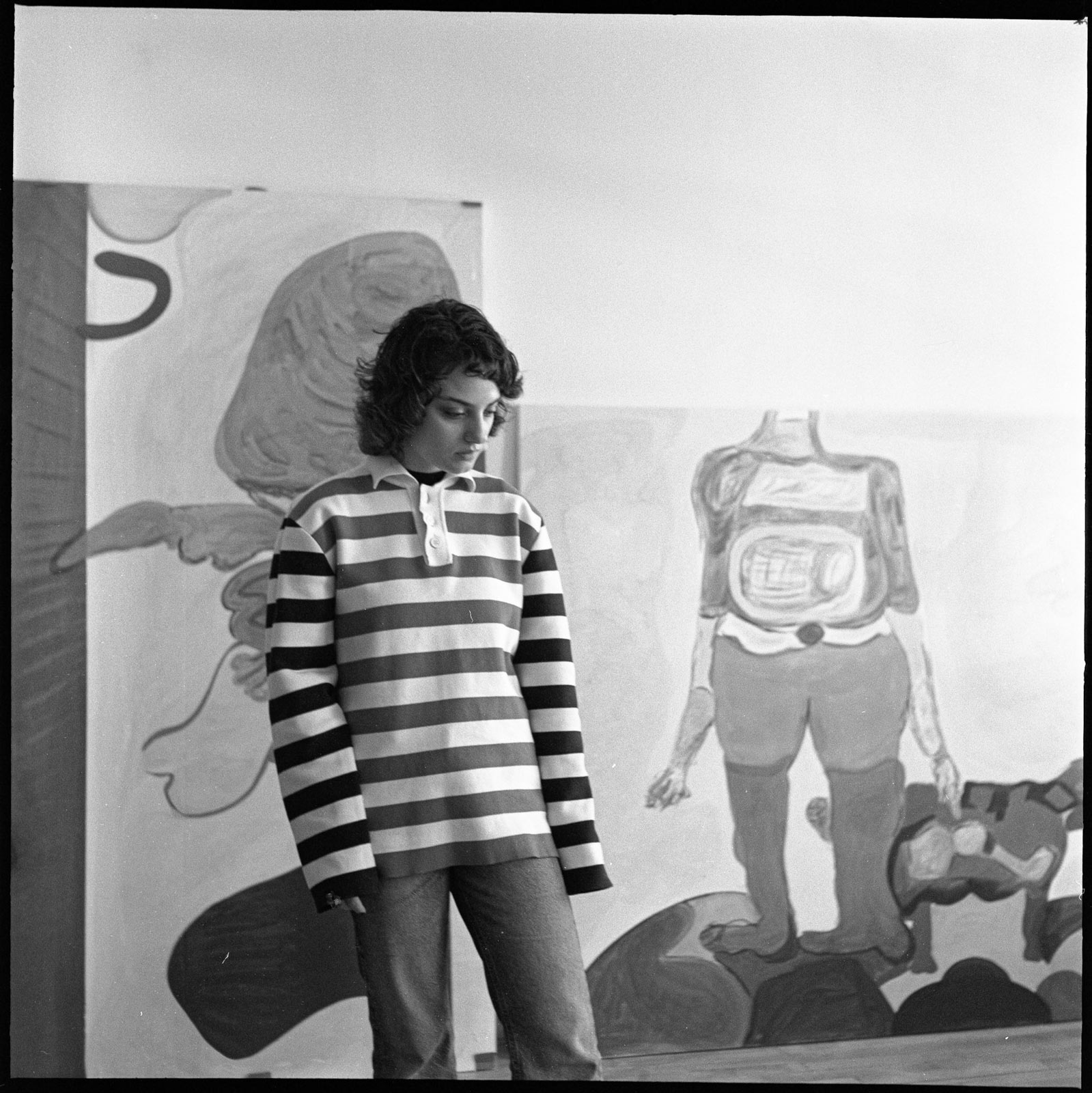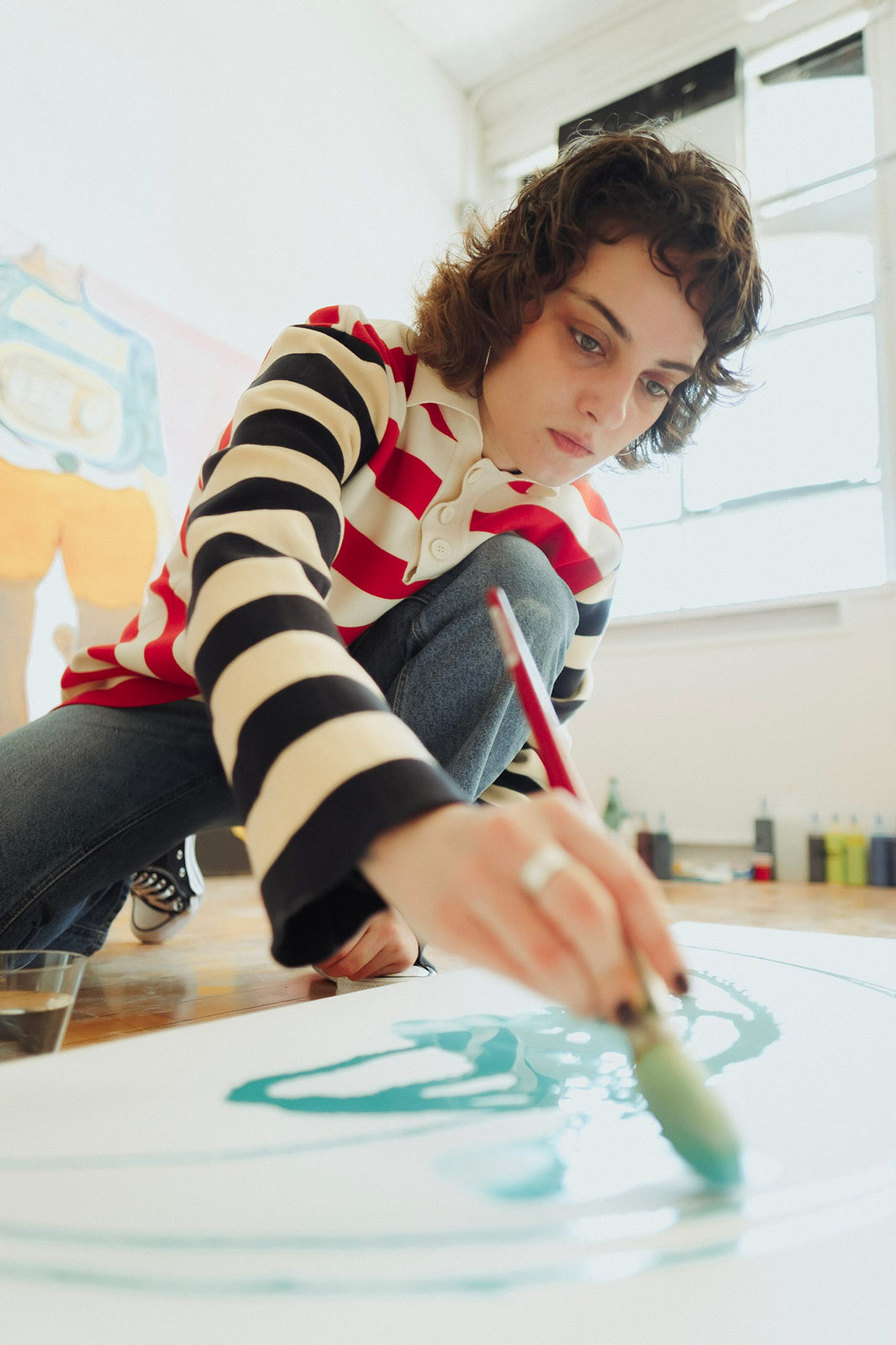The Georgian artist speaks on creative risk-taking, the chaos of New York, and stumbling upon her craft
There are artists who meticulously plan out every work, and then there are artists like Tamo Jugeli. Born and raised in Tbilisi, Georgia, the 29-year-old didn’t think this line of work was even an option. Her hometown lacked the galleries and cultural institutions that most large cities have. Jugeli felt complacent, depressed, and lost during her formative years. Still, she pursued a university degree and tried a stint in television journalism before being placed as an editor for the Georgian version of America’s Got Talent. There, in a dark editing room, she discovered the craft of art-making.
Jugeli started with drawings in sketchbooks, not yet aware that a career as an artist was in the distance. She toyed around with the idea of creating tattoos, but with the help of Georgian artist Gia Edzgveradze, she received an education in fine art, in addition to a mentor and friend. Jugeli worked her way up to the canvas and impressed Gallery Artbeat, which would bring her work to NADA Miami Beach in 2021. New York gallerist Polina Berlin saw the promise in Jugeli’s work, and took a chance.
Now, Jugeli’s paintbrush leads her hand as she creates glorious compositions filled with gestural strokes, color, shapes, and emotion. Her work lands somewhere between abstraction and figuration. The artist doesn’t sketch out her ideas; she simply lets her instincts lead the way. With her recent exhibition Lightly wrapping up at Polina Berlin Gallery, Jugeli is spending her summer in Georgia. In the meantime, she’s showing work in two group exhibitions: Artist David Salle handpicked her to be exhibited alongside Pablo Picasso, Cecily Brown, Henri Matisse, and Lucio Fontana in Beautiful, Vivid, Self-contained, a group show at the Hill Art Foundation in New York, on display through July 21. Berlin also selected Jugeli for Soft Focus at Superzoom in Paris, which opens on June 29.
Document spoke to Jugeli about her accidental career in art, how New York affects her practice, and the one piece of advice she’d give to emerging artists.
Ann Binlot: You fell into art while you were working in broadcast journalism. How?
Tamo Jugeli: In Georgia, in general, we don’t have proper museums. My only connection to art was music. I grew up with [the] internet, but [it] came into my life when I was, like, 16. I had zero fucking interest in anything. When I was graduating school, my parents were so worried [that] they forced me to go to university.
Ann: How did that lead to art?
Tamo: I heard that drawing was good for therapy. It really helped me. I was drawing every day, and I understood that I had patience and love for this. Then I met this Georgian artist, [Gia Edzgveradze], who is a philosopher-painter. He’s 70 years old and I loved his text so much. He was posting on Facebook, and I connected with him. Then, basically, I reached out to him and he became my mentor. That’s how my interaction with real art began.
Ann: So he gave you an education in fine art.
Tamo: That’s how it started. Then my Georgian gallery found me through Gia, and they started working with me.
Ann: How did you hone your painting skills?
Tamo: By painting every day. Or if you’re not painting, [looking] at other people’s paintings. Instagram really helped me in that way. [It’s] such an amazing tool. But lately, I was thinking that it has its downsides, too. It made the art world like Hollywood. I have a feeling that so many big galleries take artists just because they have huge followings. I don’t think that’s good, because that means that the masses are deciding who is a good painter, and I don’t think the masses have the eye.
“I don’t like planning—like, I just go straight to raw canvas and let the process lead me. I never think about [the] colors. Everything is a risk.”
Ann: How did you get to New York?
Tamo: I came to New York for two weeks, two years ago, because I was in this group show for Kenny Schachter. Then my Georgian gallery, they brought my work to NADA in December 2021, and that’s where Polina [Berlin] found me. She invited me to her group show, and then she said, I want to do a show with you. She gave me a studio. She gave me housing. She sold everything of mine. She sold everything I had in Georgia. She sold everything I did in the US. That’s why I already had savings to be in New York.
Ann: How does New York compare to Tbilisi?
Tamo: They have nothing in common.
Ann: Does New York make you feel more productive?
Tamo: With painting, I’m always the same—it doesn’t matter where I work. I’m a hundred times more productive in New York. I have a thousand times more energy there. My temperament syncs with New York perfectly.
Ann: What is it about the city that does that to you?
Tamo: Ambience, architecture, people, noise—everything, although I need silence and peace so much. You can get that in New York, too. You can go upstate and recharge, and then come back to the city. The main thing is that I have a feeling that life only happens in New York, because it’s so brutal. Everything is there: ugliness, beauty, unkindness, kindness. It’s not like Florence, [where you] think that everything is mirage, it’s so beautiful. Or Germany, where everyone is so polite. I don’t like static things. I like chaos, and I like feeling real.
Ann: What is a typical day, working as an artist?
Tamo: I love sleeping so much. I wake up around 1 p.m. Then I take a shower and go to the studio. That’s my day. Then home, or to see a friend, or, if I’m in New York, museums, some music shows. But mostly, yeah, that’s it. I just go to the studio and come back home.
Ann: Tell me about Lightly, your recent exhibition at Polina Berlin.
Tamo: I never have specific concepts for shows, because, for me, I’m painting paintings and then I’m exhibiting them.
Ann: It was more like you created a body of work over a set period of time.
Tamo: The past six months in New York [had] some kind of weird effect on me. The colors change. Shapes change. Everything changes. When I’m in New York, I always feel I paint a little bit differently, because of the environment. The only thing I can say about the show is that I have never been this happy about [one before]. With these paintings, I had a feeling that I really did my best.
Ann: What guides your paintbrush?
Tamo: I never think about what I will paint. I don’t like planning—like, I just go straight to raw canvas and let the process lead me. I never think about [the] colors. Everything is a risk. Sometimes it’s very, very hard and tiring. Sometimes I get so lost. But I think I always find my way out.
Ann: What artists do you admire?
Tamo: Matisse is always there for me, because he was the only painter who managed to be so light and joyful, but not even near decoration—there is no deep meaning, there is no suffering, which I love so much. Like, for example, Francis Bacon is all about that, and I love him so much—but Matisse is pure light and joy. Sometimes I have a period of Philip Guston, then I have a period of Picabia, then I have a period of de Kooning. I was so obsessed with Martin Kippenberger, and then I just could not reconnect with him.
Ann: What advice would you give to someone who wants to be an artist?
Tamo: You have to be obsessed with working, and with art. You have to be obsessed with other people—going to their studios, and being equally as excited about other people’s work as you are [about your own].















